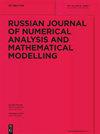冠状动脉血流个性化模型中的心肌灌注分割方法
IF 0.6
4区 数学
Q4 MATHEMATICS, APPLIED
Russian Journal of Numerical Analysis and Mathematical Modelling
Pub Date : 2023-10-01
DOI:10.1515/rnam-2023-0022
引用次数: 0
摘要
在这项工作中,我们提出了基于计算机断层扫描图像构建个性化冠状动脉血流动力学模型的方法和算法。该模型考虑了从灌注图像中获得的全壁灌注比指标,提供了分数血流储备、冠状动脉血流储备和瞬时无波比的估计。所提出的管道包括以下步骤:主动脉分割、左心室壁分割、冠状动脉分割、一维血管网络构建、左心室壁分割、模型参数个性化。我们重点研究了一种新的技术,该技术根据可用的医学图像的质量,在有限数量的冠状动脉末梢血管可见的情况下,产生特定的灌注区并计算跨壁灌注比。数值实验表明,冠状动脉介入治疗前狭窄的准确评估应综合考虑血流储备指数和心肌灌注等指标,以避免误诊。提出的模型提供了更好的理解背景的临床建议可能的手术治疗冠状动脉狭窄。本文章由计算机程序翻译,如有差异,请以英文原文为准。
Myocardial perfusion segmentation and partitioning methods in personalized models of coronary blood flow
Abstract In this work we present methods and algorithms for construction of a personalized model of coronary haemodynamics based on computed tomography images. This model provides estimations of fractional flow reserve, coronary flow reserve, and instantaneous wave-free ratio taking into account transmural perfusion ratio indices obtained from perfusion images. The presented pipeline consists of the following steps: aorta segmentation, left ventricle wall segmentation, coronary arteries segmentation, construction of 1D network of vessels, partitioning of left ventricle wall, and personalization of the model parameters. We focus on a new technique, which generates specific perfusion zones and computes transmural perfusion ratio according to the quality of available medical images with a limited number of visible terminal coronary vessels. Numerical experiments show that accurate evaluation of stenosis before precutaneous coronary intervention should take into account both fractional flow reserve indices and myocardial perfusion, as well as other indices, in order to avoid misdiagnosis. The presented model provides better understanding of the background of clinical recommendations for possible surgical treatment of a stenosed coronary artery.
求助全文
通过发布文献求助,成功后即可免费获取论文全文。
去求助
来源期刊
CiteScore
1.40
自引率
16.70%
发文量
31
审稿时长
>12 weeks
期刊介绍:
The Russian Journal of Numerical Analysis and Mathematical Modelling, published bimonthly, provides English translations of selected new original Russian papers on the theoretical aspects of numerical analysis and the application of mathematical methods to simulation and modelling. The editorial board, consisting of the most prominent Russian scientists in numerical analysis and mathematical modelling, selects papers on the basis of their high scientific standard, innovative approach and topical interest.
Topics:
-numerical analysis-
numerical linear algebra-
finite element methods for PDEs-
iterative methods-
Monte-Carlo methods-
mathematical modelling and numerical simulation in geophysical hydrodynamics, immunology and medicine, fluid mechanics and electrodynamics, geosciences.

 求助内容:
求助内容: 应助结果提醒方式:
应助结果提醒方式:


